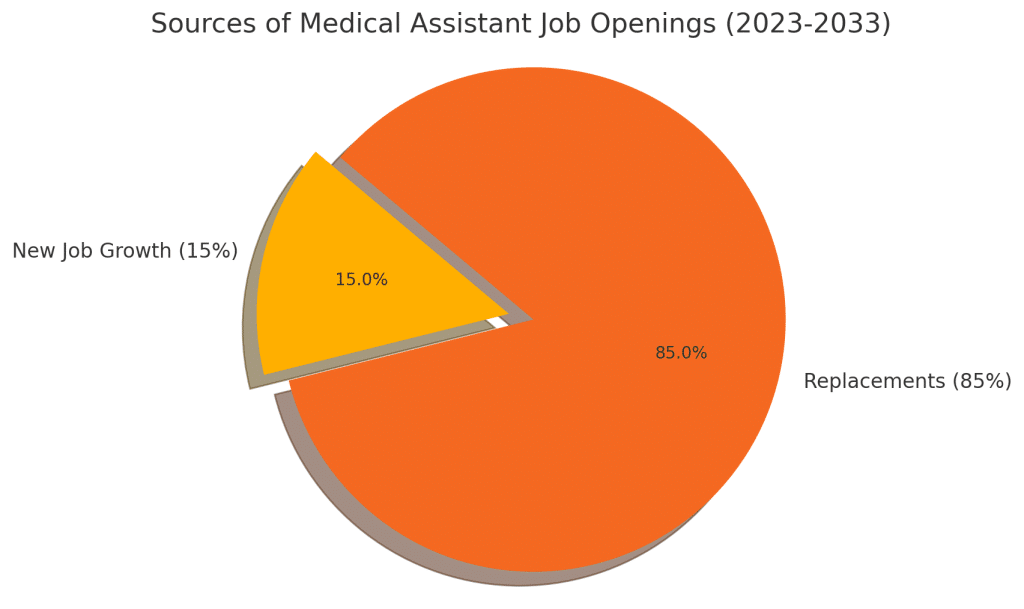Clinical Medical Assistant vs Medical Assistant: Key Facts
Wondering about the difference between a clinical medical assistant vs medical assistant? Discover their key roles and find out which path suits you best!
How Can Prior Authorization Remote Help Your Practice?
See how Portiva is making a real difference in medical practices through our clients’ experiences. Watch this short video to see the impact for yourself, and let’s talk about how we can help streamline your operations and improve patient care today!
Table of Contents

Understanding the roles of a clinical medical assistant vs medical assistant is key to making informed decisions whether you’re pursuing a healthcare career or planning to hire medical support staff. These roles often overlap in practice, but they serve distinct functions that significantly impact patient care and operational flow in medical facilities.
In this comprehensive guide, we’ll break down their responsibilities, education pathways, certifications, and how each contributes to a successful medical team through the lens of modern medical assisting.
What Is a Medical Assistant?
A medical assistant supports medical professionals in both administrative and clinical duties. They are the backbone of many healthcare offices, balancing patient-facing interactions with essential back-office work.
Medical assistants typically:
- Handle administrative tasks like scheduling appointments, managing medical records, and updating patient charts
- Perform clinical tasks including taking vital signs, preparing patients for examinations, and sometimes assisting during medical procedures
- Work in doctor’s offices, clinics, and outpatient care centers
They play a crucial role in maintaining efficient patient flow while ensuring accurate documentation and support for other medical professionals.
What Is a Clinical Medical Assistant?
A clinical medical assistant (CMA) specializes more deeply in patient care duties. While they may perform some administrative duties, their main focus lies in supporting the physician with direct patient care.
Clinical medical assistants are typically responsible for:
- Recording vital signs such as blood pressure, pulse, and temperature
- Preparing examination rooms and sterilizing medical instruments
- Assisting physicians with patient examinations, administering medications, and drawing blood samples
- Performing basic laboratory tests and handling medical equipment
Certified clinical medical assistants (CCMAs) are trained to handle more complex clinical tasks, often requiring hands-on experience and specialized certification.
Certified Medical Assistant vs Registered Medical Assistant
Two common credentials in the field are Certified Medical Assistant (CMA) and Registered Medical Assistant (RMA):
- CMAs pass the CMA exam administered by the American Association of Medical Assistants (AAMA). This is a nationally recognized credential that validates both administrative and clinical skills.
- RMAs, credentialed by the American Medical Technologists (AMT), are similarly trained. Becoming a registered medical assistant typically involves meeting specific education and experience requirements, which can vary by state or institution.
Certified clinical medical assistants are expected to hold a high school diploma and complete a formal medical assistant program before sitting for the ccma exam.
What Our Clients Say About Us!
Discover how our dedicated clients have achieved their goals and transformed their businesses with our expert solutions. Join the ranks of satisfied customers and experience the difference for yourself.
Boost your Efficiency with
Portiva's Virtual Medical Assistant Services
Portiva’s Virtual Medical Assistant Services help healthcare providers streamline administrative tasks, improve efficiency, and enhance patient care all while reducing workload and costs.
Medical Assistant
Insurance Verification
Medical Receptionist
Prior Authorization
Medical Scribe
Dental Assistant
Medical Transcription
Executive Assistant
Medical Billing
Medical Billing
Key Differences Between Clinical and General Medical Assistants
| Feature | Medical Assistant | Clinical Virtual Assistant |
|---|---|---|
| Focus | Admin + Clinical | Primarily Clinical |
| Duties | Scheduling appointments, managing medical records, taking vital signs | Assisting in medical procedures, collecting blood samples, administering medications |
| Certification | CMA, RMA | CCMA |
| Environment | Doctor's offices, outpatient clinics | Medical facilities, urgent care, hospitals |
| Skills | Administrative tasks responsibilities, patient communication | Clinical skills, basic laboratory tests, patient prep |
Educational Pathways
To become either type of assistant, one usually needs:
- A high school diploma or GED
- Completion of a medical assisting program (available at community colleges, vocational schools, or allied health colleges)
- Hands-on clinical training (often part of the certification process)
Some programs offer specializations that allow students pursuing careers as medical assistants to focus on clinical and administrative duties, depending on their career interests.

Certification Requirements
Obtaining certification not only boosts credibility but often leads to better job prospects and higher pay.
Certifications include:
Certified Clinical Medical Assistant (CCMA) – offered by the National Healthcareer Association (NHA)
Certified Medical Assistant (CMA) – issued by the AAMA
Registered Medical Assistant (RMA) – granted by the AMT
Each certification validates proficiency in medical terminology, patient care, and both administrative and clinical responsibilities.
Continuing education courses are often required to maintain certification, especially for those pursuing more clinical responsibilities.
Work Environments and Job Responsibilities
Many medical assistants and clinical medical assistants find employment in:
- Private doctor’s offices
- Urgent care centers
- Outpatient facilities
- Hospitals
Their responsibilities may vary based on state laws and employer requirements. For example:
- In some states, medical assistants can administer medications or record patient histories under physician supervision
- In hospitals, clinical medical assistants may assist during minor surgeries or perform more advanced procedures like ECGs
Why Employers Care About the Difference
Hiring the right assistant can impact both patient satisfaction and workflow efficiency. Practices that deal with complex procedures often prefer certified medical assistants, while those focused on routine visits may benefit from hiring medical assistants with strong administrative skills.
A well-trained assistant helps:
- Maintain patient medical records accurately
- Reduce physician workload
- Provide seamless communication between medical professionals
Skills That Set Clinical Medical Assistants Apart
While both roles require empathy, organization, and attention to detail, clinical medical assistants also need:
- Mastery of clinical skills like phlebotomy, sterilization techniques, and medical history recording
- Familiarity with medical instruments and procedures
- Comfort performing direct patient care under pressure
Their ability to follow medical charts and physician instructions precisely is critical to ensuring safety and compliance.
Demand in the Job Market

According to the U.S. Bureau of Labor Statistics (BLS), the employment of medical assistants is projected to grow 15 percent from 2023 to 2033, much faster than the average for all occupations.
About 119,800 openings for medical assistants are projected each year, on average, over the decade. Many of those openings are expected to result from the need to replace workers who transfer to different occupations or exit the labor force, such as to retire.
Source: U.S. Bureau of Labor Statistics

Real-World Example
Consider a busy cardiology clinic. They need staff who can:
- Greet patients and update their medical charts
- Collect clinical vitals before doctor consultation
- Prepare ECG machines and assist during patient examinations
A clinical medical assistant with certification can fulfill all of these roles with confidence, reducing the number of personnel needed and streamlining patient appointments.
Advantages of Becoming a Board-Certified Clinical Assistant
- Higher starting salaries
- Access to more specialized roles in hospitals and labs
- Increased trust from physicians and patients
- Greater responsibility in administering medications and conducting procedures
Employers looking to hire medical assistants will often choose candidates with these credentials for more hands-on roles.
How to Choose the Right Path
Ask yourself the following:
- Do you enjoy working directly with patients in clinical settings?
- Are you comfortable performing minor procedures?
- Do you prefer office-based responsibilities like data entry and scheduling?
If you’re looking for more clinical responsibilities, pursue training as a clinical medical assistant. If you prefer a broader support role with a mix of duties, a general medical assistant certification might be ideal.
Training Duration and Cost
Programs vary by school but typically require:
- 9 to 12 months for certificate programs
- 18 to 24 months for associate degrees
Many health education schools offer financial aid and flexible schedules. Expect costs to range from $3,000 to $15,000 depending on the length and depth of the program.
Continuing Education and Career Growth
Advancing your career doesn’t stop with certification. Many professionals in medical assisting pursue continued learning to broaden their clinical capabilities and specialize in high-demand fields. Consider:
Continuing education courses to expand clinical scope
Specializing in areas like pediatrics, dermatology, or cardiology
Becoming a medical assistant instructor
With experience, many certified medical assistants move into leadership roles or transition into nursing programs.
Final Thoughts: Which Role Is Right for You?
Choosing between a clinical medical assistant and a medical assistant depends on your career goals and interest in either clinical tasks or administrative responsibilities. Both roles are vital to the healthcare team and offer fulfilling, impactful careers in the growing field of medical assisting.
Whether you’re planning to start your journey or looking to hire medical assistants for your practice, understanding these distinctions helps you make better choices for success.
Streamline Your Practice with a Virtual Medical Assistant
Say goodbye to the need for a full-time, in-office medical assistant. Thanks to modern technology and the rise of telemedicine, hiring a virtual medical assistant is now easier and more efficient than ever.
Looking for a HIPAA-compliant professional who understands the unique needs of your practice? Portiva connects you with experienced virtual assistants ready to support your workflow.
Discover how a virtual assistant from Portiva can help you save time, reduce overhead, and focus on what matters most—your patients. Contact us today to learn more.

